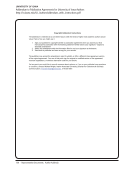SPEC Kit 343: Library Support for Faculty/Researcher Publishing · 89
CORNELL UNIVERSITY
Copyright Management
http://copyright.cornell.edu/policies/copyright_management.cfm
Copyright Information Center
http://copyright.cornell.edu/policies/copyright_management.cfm[9/17/14 1:42:15 PM]
WHAT AUTHORS CAN DO
Video Tutorial: Copyright ownership: Preserving your rights as an author
Featuring: Peter Hirtle
Video Tutorial: Copyright: Retaining Author's Rights in Agreements with
Publishers Featuring: John Saylor
A copyright is actually a bundle of rights. Traditionally all of them have been
transferred to the publisher as a requirement for publication, but it doesn't
have to be this way. There are a number of other options available to you.
Option 1: You retain all rights and license publication.
The ideal solution from the author's perspective would be to retain the
copyright and all associated rights in their work while licensing to publishers
only the rights the publisher needs to conduct its business. You get to
determine who can use your scholarship.
You can, for example, grant the publisher an exclusive license for the first
formal publication of the work (in print, digital ,or some other form). In
addition, you might want to grant the publisher non-exclusive rights to
authorize (or accomplish themselves) the following:
Subsequent republication of the work
Reformatting of the publication (from print to microfilm or digital formats,
for example)
Distribution via document delivery services or in course packs
The key issue with Option 1 is determining what are the minimum bundle of
rights that the publisher needs in order to protect its investment in the
publication. This will vary from publisher to publisher. We have some sample
language that can help.
Option 2: You transfer your copyright, but retain some specified
rights.
You can assign your copyright to the publisher, but at the same time reserve
some specific rights for yourself. Rights you might want to receive from the
publisher include:
The right to make reproductions for use in teaching, scholarship, and
research
The right to borrow portions of the work for use in other works
The right to make derivative works
The right to alter the work, add to the work, or update the content of the
work
The right to be identified as the author of the work
The right to be informed of any uses, reproductions, or distributions of the
CORNELL UNIVERSITY
Copyright Management
http://copyright.cornell.edu/policies/copyright_management.cfm
Copyright Information Center
http://copyright.cornell.edu/policies/copyright_management.cfm[9/17/14 1:42:15 PM]
WHAT AUTHORS CAN DO
Video Tutorial: Copyright ownership: Preserving your rights as an author
Featuring: Peter Hirtle
Video Tutorial: Copyright: Retaining Author's Rights in Agreements with
Publishers Featuring: John Saylor
A copyright is actually a bundle of rights. Traditionally all of them have been
transferred to the publisher as a requirement for publication, but it doesn't
have to be this way. There are a number of other options available to you.
Option 1: You retain all rights and license publication.
The ideal solution from the author's perspective would be to retain the
copyright and all associated rights in their work while licensing to publishers
only the rights the publisher needs to conduct its business. You get to
determine who can use your scholarship.
You can, for example, grant the publisher an exclusive license for the first
formal publication of the work (in print, digital ,or some other form). In
addition, you might want to grant the publisher non-exclusive rights to
authorize (or accomplish themselves) the following:
Subsequent republication of the work
Reformatting of the publication (from print to microfilm or digital formats,
for example)
Distribution via document delivery services or in course packs
The key issue with Option 1 is determining what are the minimum bundle of
rights that the publisher needs in order to protect its investment in the
publication. This will vary from publisher to publisher. We have some sample
language that can help.
Option 2: You transfer your copyright, but retain some specified
rights.
You can assign your copyright to the publisher, but at the same time reserve
some specific rights for yourself. Rights you might want to receive from the
publisher include:
The right to make reproductions for use in teaching, scholarship, and
research
The right to borrow portions of the work for use in other works
The right to make derivative works
The right to alter the work, add to the work, or update the content of the
work
The right to be identified as the author of the work
The right to be informed of any uses, reproductions, or distributions of the






































































































































































